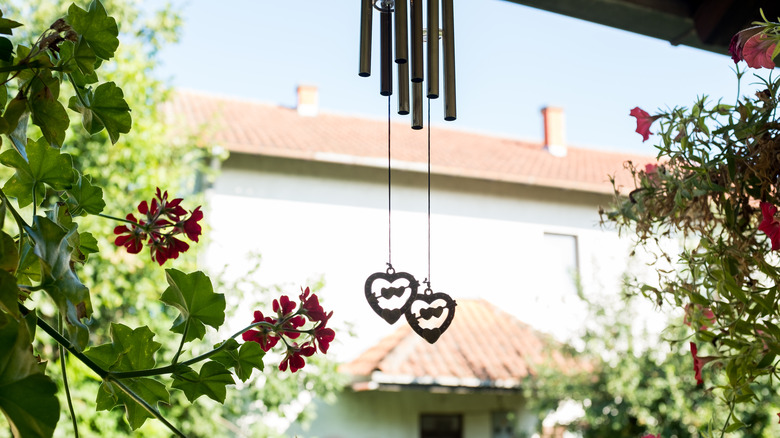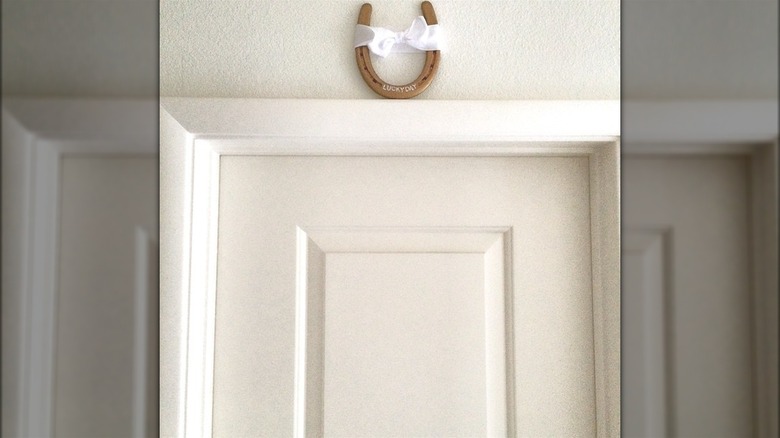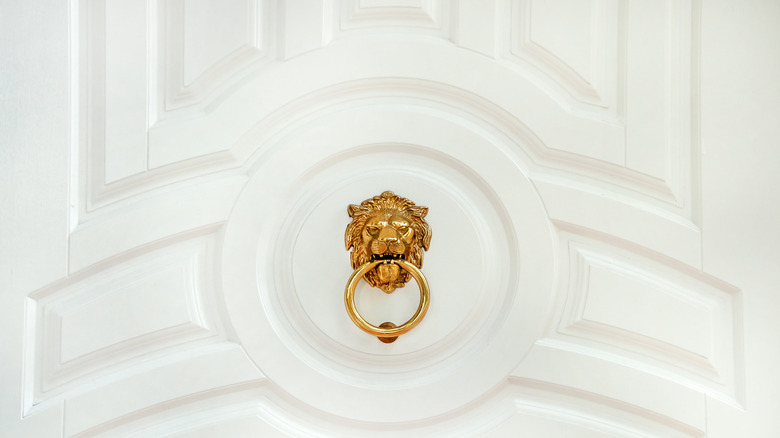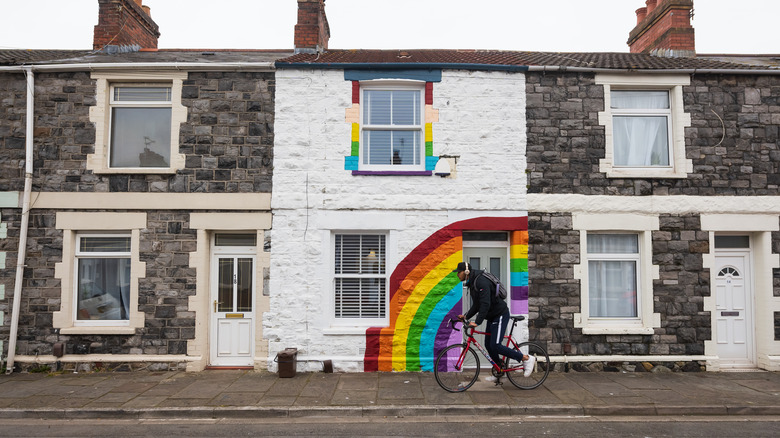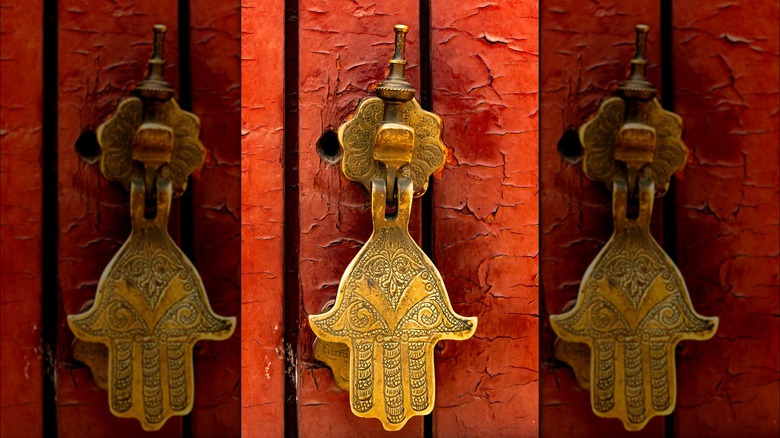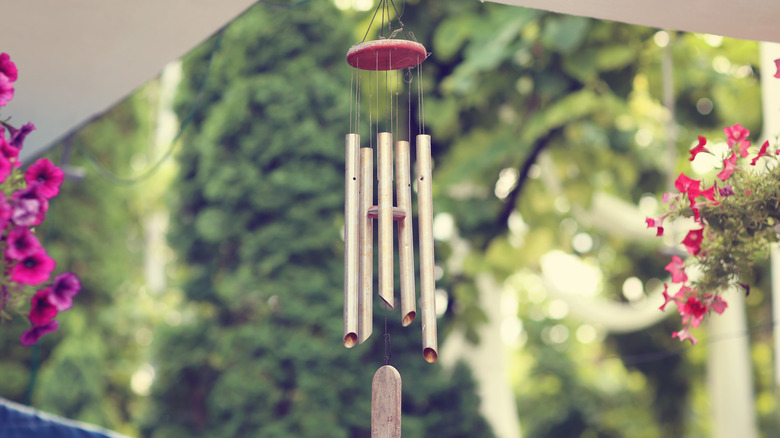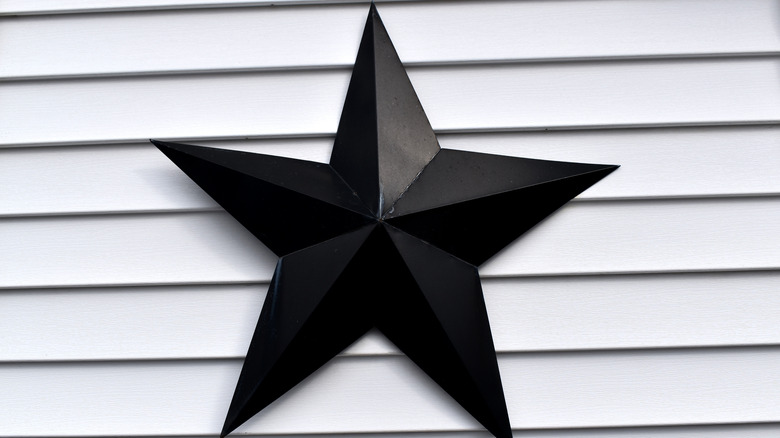What It Means If You See These Decorations On The Outside Of Someone's Home
We may receive a commission on purchases made from links.
Have you ever seen a statue, decoration, or symbol on the exterior of a house and wondered if its meaning extends deeper than simple décor? Nearly every culture holds particular symbols in high regard due to a history of religious or superstitious ties to properties like protection or prosperity. Many of these symbols are routinely placed above, on, or near a home's front door, since it is often believed that this is where both blessings and any potential threats enter — or attempt to enter — one's home.
You may even have décor displayed at the front of your own home without being aware of its symbolic meaning. The next time you notice an ordinary item like a wind chime on the outside of a house, stop and think about the sentiment that is being represented. Consider this your guide to the deeper meanings of the most common symbolic decorations frequently displayed on the exteriors of homes and outbuildings.
Horseshoes signify good luck
It's pretty common to see someone displaying a horseshoe above their home's front door. It's easy to assume that this symbol is simply a sign of a household that appreciates horses, cowboys, or other Southwestern U.S. traditions (and this may be true, especially for homes in these regions of the United States), and to some, it may seem as generic a decoration as a flag or a wreath. However, the symbolism associated with horseshoes runs much deeper than actual horses and Wild West sentiment.
Horseshoes are strongly associated with good luck, protection from misfortune, and fertility. Since horseshoes were originally crafted from iron — which was once believed to have magical properties — they quickly came to represent an almost supernatural sense of good fortune amongst ancient Greeks and early Christians. There is also a popular Irish myth involving Saint Dunstan applying a hot horseshoe to the devil's hoof as well, resulting in people hanging them their doors to keep the devil away.
Lions symbolize honor, protection, and ... paying off mortgages?
If you've ever seen a particularly prestigious home — either in person or on the big screen — you may have noticed that it was adorned with a lion knocker, plaque, or statue. In many cases, lion figurines on or in front of one's home are arranged in pairs and can even appear a bit aggressive or threatening. They are often crafted out of precious metals like bronze or gold or strong natural stone such as marble.
You may have wondered if there might be a secret meaning behind the king of the jungle's likeness. As you might suspect, a lion symbolizes fierce protection, power, prosperity, honor, pride, and regality. These representations reach back centuries into Chinese, Italian, and Buddhist history and mythology. In some geographical areas such as Quebec, lion statues can indicate that the home in question is fully owned by the homeowner and that their mortgage is fully paid off.
Rainbows have a variety of meanings
Few images evoke such magical and mystical sentiments as that of a rainbow. You might spot a rainbow in the form of a stained-glass feature, a mural, a decal, or even a flag on the exterior of a home. While it's easy to imagine that a rainbow would represent joyful or hopeful properties, there are specific meanings behind the symbol, and those meanings have shifted throughout history and across cultures.
Shockingly, some ancient cultures originally held negative beliefs about the meaning of rainbows, ranging from omens of disease to associations with serpents and the devil. Conversely, Irish, Hawaiian, and some Native American lore places the rainbow in a positive light, associated with gold, gods, and the sacred sun. According to Buddhist philosophy, reaching the highest state of spiritual being includes transformation into a rainbow of light.
In more recent history, rainbow imagery — particularly in flag form — has been adopted by the LGBTQ+ community and is often flown by both members and allies of that community. Plenty of LGBTQ+ artists incorporate rainbow motifs into their designs. Rainbow flags themselves come in various patterns and shades, and anyone curious about what a particular flag means can easily look up the constituent colors. During the COVID-19 pandemic, rainbow symbols in windows signified hope, gratitude, and encouragement, especially for medical professionals.
Hamsas are protective religious symbols
You may or may not recognize the term "hamsa," but you've almost definitely seen the symbol. The hamsa — also known as the hand of Fatima or the hand of Miriam — appears as a hand that often features an eye in the center. You may spot one on, near, or above a home's front door. This is due to the belief that the hamsa offers protection from the "evil eye." The evil eye refers to a persistent multicultural belief that certain individuals can cause harm to others by casting an envious or hateful glance their way.
Although it is sometimes viewed as an occult symbol, the hamsa actually roots in Judaism, Christianity, Islam, and pagan traditions. While the symbol's protective properties are quite well-known, many don't realize that there is a second meaning when the hand is inverted. When placed upside down, the hamsa symbolizes successful manifestation, good luck, and fertility.
Wind chimes bring zen vibes and peace
Wind chimes are so common to see that it may have never even occurred to you that they might have any particular meaning, symbolism, or history attached to them. Often hung on a home's front porch, wind chimes can be constructed out of various woods or metals and make noise as the wind blows and clanks them together. While some people adore these sounds, others may find them annoying or even eerie. What neither tend to realize is that wind chimes aren't just decorative.
In ancient China, wind chimes were used to scare away the evil spirits that were believed to lurk about in the dark of night. As time went on, the sounds created by these chimes became associated with spiritual, emotional, and energetic healing via sound therapy. Hanging wind chimes might bring you peace and help you relax. Other practical uses for wind chimes include scaring away birds that might munch on your garden fruit or flowers and honoring those who have recently passed away.
Anchors have an ancient coded meaning
If you've ever lived in or visited a coastal region, you've likely noticed decorative anchors attached to the front doors or displayed in the windows of homes. Displaying an anchor as a symbol of respect and appreciation for whichever body of water a home is near makes perfect sense, but the symbolism of an anchor actually goes far beyond a simple nod to the nautical. In addition to representing strong ties, security, and immovable bonds, the anchor actually once served as a secret symbol.
During the earliest days of Christianity, Christians were brutally oppressed by the Roman majority. In order to identify and secretly communicate with one another, Christians would display the anchor symbol — largely due to its visual similarity to a cross. Some modern Christians may still display the anchor as a symbol of their religious beliefs along with its other themes of family ties, loyalty, and perseverance through storms.
Barn stars protect farms and households
Of all the most common decorative items frequently spotted on the exteriors of homes across America, the star is likely the most seen and the least understood. Houses, barns, garages, and even playhouses across small towns and the rural countryside proudly display five-pointed stars on their broadsides — often in the color red or black. These stars are also known as barn stars, Pennsylvania stars, or primitive stars. As you might suspect, stars are more than mere decorations.
According to early settlers from Germany and the Netherlands, a barn star on the outside of someone's home signifies protection from evil and prosperity in farming. A barn star's meaning can be further explained by its color. Black and blue stars signify spiritual protection, a green star symbolizes fertility, while a yellow star is said to bring warm, sunny love and joy. While the stars are traditionally seen on the exterior of farms of German-American families, they've become so ubiquitous and so entrenched in modern farmhouse décor that it's not uncommon to see some families displaying barn stars indoors.
